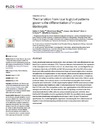Please use this identifier to cite or link to this item:
https://accedacris.ulpgc.es/jspui/handle/10553/73883
| Title: | The transition from local to global patterns governs the differentiation of mouse blastocysts | Authors: | Fischer, Sabine C. Corujo-Simon, Elena Lilao Garzón, Joaquín Stelzer, Ernst H.K. Muñoz Descalzo, Silvia |
Editors: | Kelly, Gregory M. | UNESCO Clasification: | 32 Ciencias médicas 320102 Genética clínica 2407 Biología celular 240901 Embriología |
Keywords: | Embrylogy Blastocyst Mice Transcripction factors Endoderm, et al |
Issue Date: | 2020 | Journal: | PLoS ONE | Abstract: | During mammalian blastocyst development, inner cell mass (ICM) cells differentiate into epiblast (Epi) or primitive endoderm (PrE). These two fates are characterized by the expression of the transcription factors NANOG and GATA6, respectively. Here, we investigate the spatio-temporal distribution of NANOG and GATA6 expressing cells in the ICM of the mouse blastocysts with quantitative three-dimensional single cell-based neighbourhood analyses. We define the cell neighbourhood by local features, which include the expression levels of both fate markers expressed in each cell and its neighbours, and the number of neighbouring cells. We further include the position of a cell relative to the centre of the ICM as a global positional feature. Our analyses reveal a local three-dimensional pattern that is already present in early blastocysts: 1) Cells expressing the highest NANOG levels are surrounded by approximately nine neighbours, while 2) cells expressing GATA6 cluster according to their GATA6 levels. This local pattern evolves into a global pattern in the ICM that starts to emerge in mid blastocysts. We show that FGF/MAPK signalling is involved in the three-dimensional distribution of the cells and, using a mutant background, we further show that the GATA6 neighbourhood is regulated by NANOG. Our quantitative study suggests that the three-dimensional cell neighbourhood plays a role in Epi and PrE precursor specification. Our results highlight the importance of analysing the three-dimensional cell neighbourhood while investigating cell fate decisions during early mouse embryonic development. | URI: | https://accedacris.ulpgc.es/handle/10553/73883 | ISSN: | 1932-6203 | DOI: | 10.1371/journal.pone.0233030 | Source: | PLoS ONE [EISSN 1932-6203], v. 15 (5), e0233030 (Mayo 2020) |
| Appears in Collections: | Artículos |
SCOPUSTM
Citations
16
checked on Jun 8, 2025
WEB OF SCIENCETM
Citations
17
checked on Jun 8, 2025
Page view(s)
82
checked on Jan 10, 2026
Download(s)
93
checked on Jan 10, 2026
Google ScholarTM
Check
Altmetric
Share
Export metadata
Items in accedaCRIS are protected by copyright, with all rights reserved, unless otherwise indicated.
